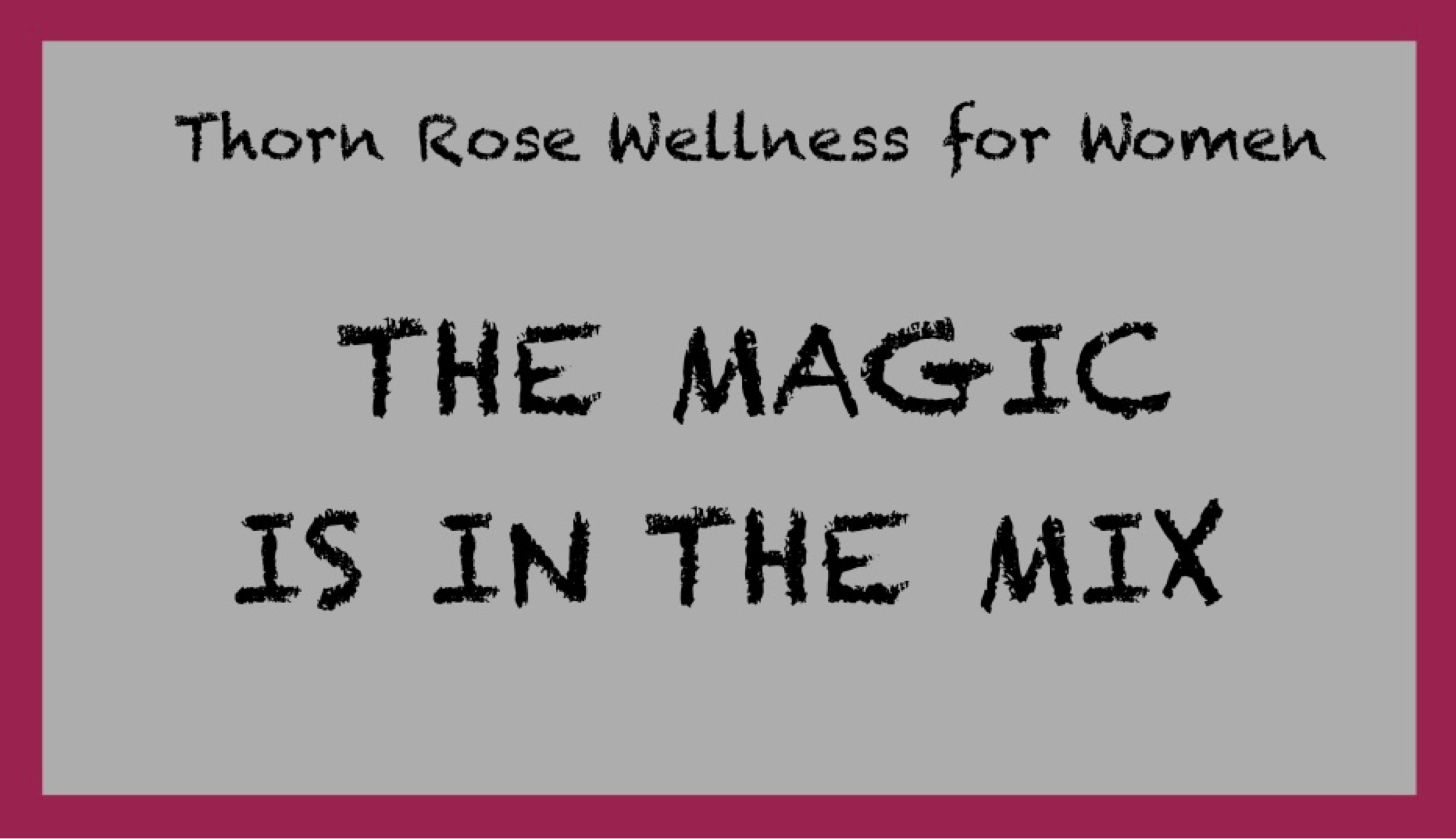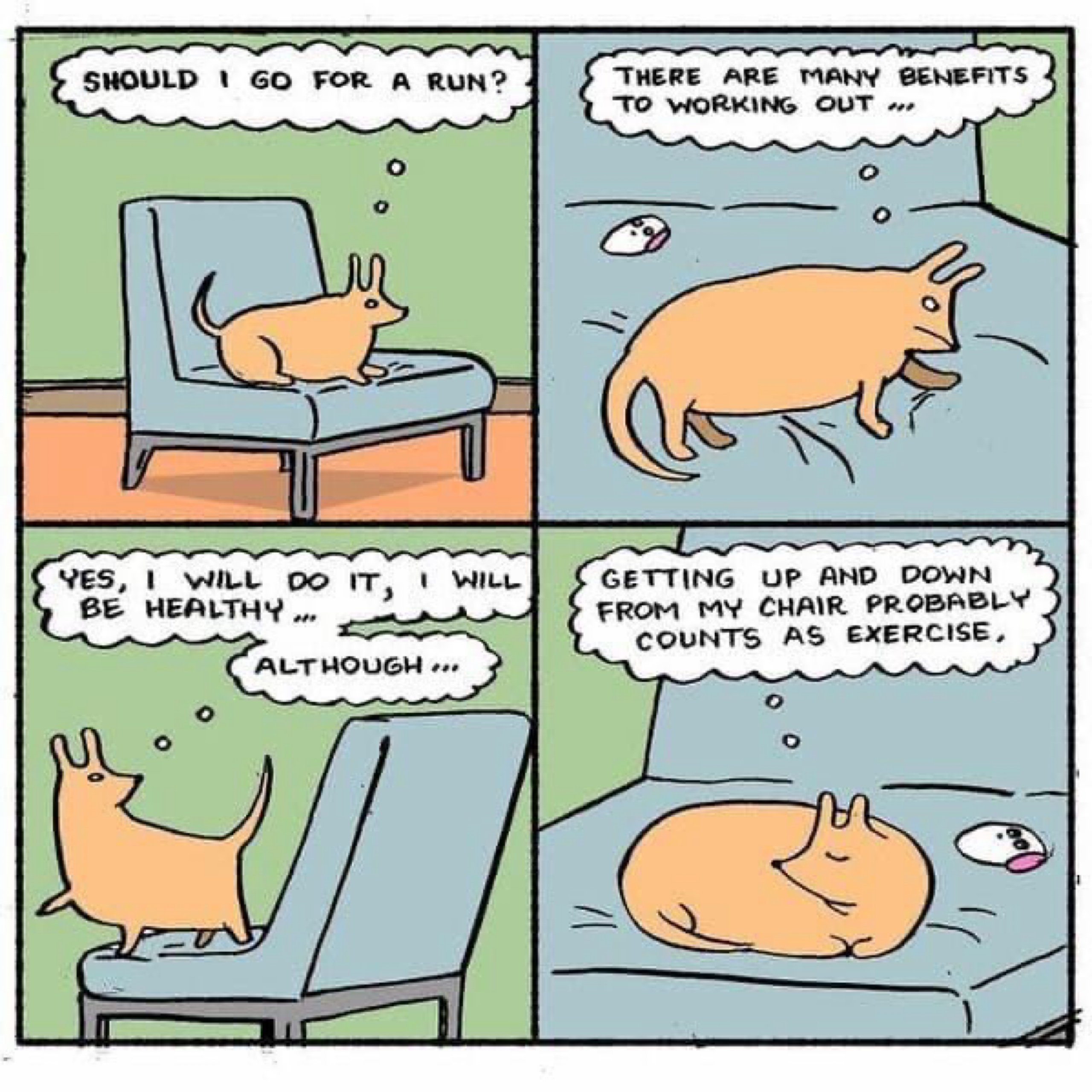The Magic is in the Mix

We need a range of different types of movement to gain the most benefit, and the magic is very much in the mix.
Our first and most important principle or approach could be summarised by the motto “move more”. Whether this is adding a number of short walks to your day, performing a few simple exercises OTHEH, being less efficient around the house (more trips up the stairs), swimming, cycling, playing with the kids, fidgeting, dancing - whatever it might be, the principle is to get the large muscle groups moving as often as you can. They say “sitting is the new smoking” and just making sure that you don’t sit for too long has major benefits for your health.

Thanks to Awesome Dachsund for this cartoon.
The advantage of this approach is that you don’t have to get changed, you don’t have to get showered, and you don’t have to warm up or cool down extensively either. It does good things for your blood sugar control, since you have to “crank yourself up” each time, and it tones and conditions the muscles really quite effectively. If you are starting from a place of not exercising much at all, you might notice some real changes when you start incorporating more movement. If you are “elite athlete” level, you wouldn’t notice any increase in your strength or fitness, but your mobility might improve, and there would still be benefits from moving regularly, as well as doing whatever athletic training you do.
However, this approach won’t do a huge amount for your cardio-vascular health, and it might not provide quite enough resistance to confer the benefits of proper strength training.
So it’s a good foundation, and if you did nothing else you would still be accruing excellent benefits for your health, you really would, but you would be missing out on some of the very valuable extra advantages that high intensity and resistance training could provide.
So, in addition to very regular movement of the kind we suggest you incorporate daily, you could add in resistance and you could add in higher intensity.
There are lots of different possible protocols for both, depending somewhat on the results you are looking to achieve and what your ultimate goal is, but there is no doubt at all that adding this training into your exercise mix will add benefits that slow and steady just can’t manage.
Resistance training can be bodyweight, or you can use resistance bands or weighted objects, and it can be done with progressive overload in mind to increase muscle mass, or you can, quite simply, just start adding it in whenever you get the chance. It does require you to be more warmed up than our simple “move more” approach, but the warm up doesn’t have to be complicated or long-winded, and you may find yourself noticing times when you are sufficiently warmed up that you could simply add in some resistance training. Perhaps when you are back from a brisk walk, or after you have done some other exercises. As a simple preparatory stage, without worrying about sets or numbers of reps, or how much weight you are lifting, you could just do, for example, ten resisted squats, or ten twisted rows, whenever you feel adequately warmed up, and choose a weight or resistance band that feels significant to you - that is to say, a bit heavy. There is little point in doing tens of reps with a weight that is so light you can barely notice it, and in the early stages you shouldn’t be using a weight or resistance that makes you wonder if you can manage it.
You could do this level of resistance training every day, but once you get into lifting/pulling quite heavy, you need decent rest in between sessions. As in, you would need a day off from resistance training before you worked the same muscle groups again. We will look at this protocol in more detail in the upcoming weeks, once you have had a chance to ease your way into training with more resistance.

High intensity work can also be eased into rather than going all out. Ultimately, you are looking to be able to do a workout of around 20-25 minutes, including warm up and cool down, with between 12 and 16 segments of really high intensity work. For example, warm up 5 minutes, then 30 seconds high intensity, 30 seconds low intensity times four. Then low intensity for a couple of minutes, and repeat twice, or three times, then cool down for a few minutes. There are other protocols available. The high intensity wants to be at around 75-85% of your maximum heart rate, or if you don’t want to measure that, you can go be “perceived effort” and you want to perceive the effort or exertion as strenuous. You certainly wouldn’t be able to hold a conversation at the same time. These workouts are so effective that you would do a maximum of three per week, but two or even one would bring results. (Remember that no studies have been done on minimum effective dose, but two every other week have shown measurable benefits).
So, whilst working your way towards this, you could follow the protocol suggested above, but don’t go so all out - just increase your effort a bit. Or you could push to a higher intensity and take longer breaks in between, and only do one set. So that would like this:
Warm up for 3 minutes with low intensity effort, high intensity for 30 seconds, low intensity for a minute and a half, repeat three or four times, and then cool down. Next time, add another rep or two, or shorten the low intensity segments, or both.
Do you get the idea? You are just looking to incrementally progress towards the end result, giving your body-mind time to adjust and adapt.

Apart from the fact that it’s quite a lot of effort, there’s no reason at all not to do HIIT and resistance training on the same day. In fact, it makes a lot of sense, since the active recovery days in between, where you would go back to regular but low intensity movement, would be excellent recovery for both activities.
Our mobility sequences are great for active recovery, as is yoga, or a stretch class. We’ll also be looking at ways to release muscle tension, which is an important part of self-care once we start challenging ourselves more, and also if we have tight weak muscles from too much inactivity.
Let me know if you would like me to lay out more specifically some example protocols for these, or to film follow along sequences for Resistance Training and HIIT. And do let me know how you are getting on with all of this - it’s always lovely to hear from you.